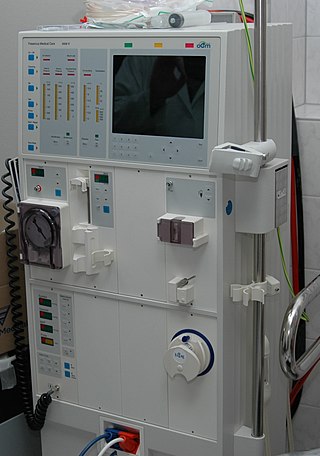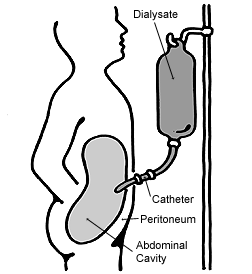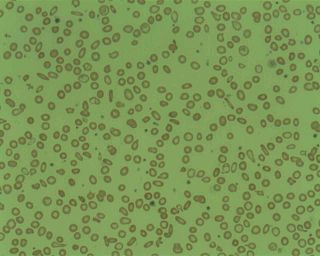Related Research Articles

Kidney dialysis is the process of removing excess water, solutes, and toxins from the blood in people whose kidneys can no longer perform these functions naturally. This is referred to as renal replacement therapy. The first successful dialysis was performed in 1943.

Kidney failure, also known as end-stage kidney disease, is a medical condition in which the kidneys can no longer adequately filter waste products from the blood, functioning at less than 15% of normal levels. Kidney failure is classified as either acute kidney failure, which develops rapidly and may resolve; and chronic kidney failure, which develops slowly and can often be irreversible. Symptoms may include leg swelling, feeling tired, vomiting, loss of appetite, and confusion. Complications of acute and chronic failure include uremia, hyperkalaemia, and volume overload. Complications of chronic failure also include heart disease, high blood pressure, and anaemia.

Uremia is the term for high levels of urea in the blood. Urea is one of the primary components of urine. It can be defined as an excess in the blood of amino acid and protein metabolism end products, such as urea and creatinine, which would be normally excreted in the urine. Uremic syndrome can be defined as the terminal clinical manifestation of kidney failure. It is the signs, symptoms and results from laboratory tests which result from inadequate excretory, regulatory, and endocrine function of the kidneys. Both uremia and uremic syndrome have been used interchangeably to denote a very high plasma urea concentration that is the result of renal failure. The former denotation will be used for the rest of the article.

Hemodialysis, also spelled haemodialysis, or simply dialysis, is a process of filtering the blood of a person whose kidneys are not working normally. This type of dialysis achieves the extracorporeal removal of waste products such as creatinine and urea and free water from the blood when the kidneys are in a state of kidney failure. Hemodialysis is one of three renal replacement therapies. An alternative method for extracorporeal separation of blood components such as plasma or cells is apheresis.

Chronic kidney disease (CKD) is a type of kidney disease in which a gradual loss of kidney function occurs over a period of months to years. Initially generally no symptoms are seen, but later symptoms may include leg swelling, feeling tired, vomiting, loss of appetite, and confusion. Complications can relate to hormonal dysfunction of the kidneys and include high blood pressure, bone disease, and anemia. Additionally CKD patients have markedly increased cardiovascular complications with increased risks of death and hospitalization.

Peritoneal dialysis (PD) is a type of dialysis that uses the peritoneum in a person's abdomen as the membrane through which fluid and dissolved substances are exchanged with the blood. It is used to remove excess fluid, correct electrolyte problems, and remove toxins in those with kidney failure. Peritoneal dialysis has better outcomes than hemodialysis during the first couple of years. Other benefits include greater flexibility and better tolerability in those with significant heart disease.

Metabolic acidosis is a serious electrolyte disorder characterized by an imbalance in the body's acid-base balance. Metabolic acidosis has three main root causes: increased acid production, loss of bicarbonate, and a reduced ability of the kidneys to excrete excess acids. Metabolic acidosis can lead to acidemia, which is defined as arterial blood pH that is lower than 7.35. Acidemia and acidosis are not mutually exclusive – pH and hydrogen ion concentrations also depend on the coexistence of other acid-base disorders; therefore, pH levels in people with metabolic acidosis can range from low to high.

Microcytic anaemia is any of several types of anemia characterized by smaller than normal red blood cells. The normal mean corpuscular volume is approximately 80–100 fL. When the MCV is <80 fL, the red cells are described as microcytic and when >100 fL, macrocytic. The MCV is the average red blood cell size.

Home hemodialysis (HHD) is the provision of hemodialysis to purify the blood of a person whose kidneys are not working normally, in their own home. One advantage to doing dialysis at home is that it can be done more frequently and slowly, which reduces the "washed out" feeling and other symptoms caused by rapid ultrafiltration, and it can often be done at night, while the person is sleeping.
In medicine, Kt/V is a number used to quantify hemodialysis and peritoneal dialysis treatment adequacy.
Anemia of chronic disease (ACD) or anemia of chronic inflammation is a form of anemia seen in chronic infection, chronic immune activation, and malignancy. These conditions all produce elevation of interleukin-6, which stimulates hepcidin production and release from the liver. Hepcidin production and release shuts down ferroportin, a protein that controls export of iron from the gut and from iron storing cells. As a consequence, circulating iron levels are reduced. Other mechanisms may also play a role, such as reduced erythropoiesis. It is also known as anemia of inflammation, or anemia of inflammatory response.
Deferoxamine (DFOA), also known as desferrioxamine and sold under the brand name Desferal, is a medication that binds iron and aluminium. It is specifically used in iron overdose, hemochromatosis either due to multiple blood transfusions or an underlying genetic condition, and aluminium toxicity in people on dialysis. It is used by injection into a muscle, vein, or under the skin.

Robert Provenzano is an American nephrologist. He is also an Associate Clinical Professor of Medicine at Wayne State University School of Medicine.
Amyloidosis is the accumulation on misfolded protein fibers in the body. This is very common condition associated with many of the chronic illness. Haemodialysis-associated amyloidosis is a form of systemic amyloidosis associated with chronic kidney failure. Even if this is common in CKD patients with chronic regular dialysis, it can be also seen in patient with CKD but have never dialysed too.
Dialysis Clinic, Inc. is a nonprofit medical corporation founded in 1971 and chartered as a 501(c)(3) tax-exempt organization under IRS regulations.

Salicylate poisoning, also known as aspirin poisoning, is the acute or chronic poisoning with a salicylate such as aspirin. The classic symptoms are ringing in the ears, nausea, abdominal pain, and a fast breathing rate. Early on, these may be subtle, while larger doses may result in fever. Complications can include swelling of the brain or lungs, seizures, low blood sugar, or cardiac arrest.
Nathan W. Levin is an American physician and founder of the Renal Research Institute, LLC., a research institute dedicated to improving the outcomes of patients with kidney disease, particularly those requiring dialysis. Levin is one of the most prominent and renowned figures in clinical nephrology as well as nephrology research. He has authored multiple book chapters and over 350 peer-reviewed publications, including articles in leading journals such as Nature, the New England Journal of Medicine, and The Lancet.
Calcium acetate/magnesium carbonate is a fixed-dose combination drug that contains 110 mg calcium and 60 mg magnesium ions and is indicated as a phosphate binder for dialysis patients with hyperphosphataemia. It is registered by Fresenius Medical Care under the trade names Renepho (Belgium) and OsvaRen.
Sucroferric oxyhydroxide, sold under the brand name Velphoro, is a non-calcium, iron-based phosphate binder used for the control of serum phosphorus levels in adults with chronic kidney disease (CKD) on haemodialysis (HD) or peritoneal dialysis (PD). It is used in form of chewable tablets.

Lithium toxicity, also known as lithium overdose, is the condition of having too much lithium. Symptoms may include a tremor, increased reflexes, trouble walking, kidney problems, and an altered level of consciousness. Some symptoms may last for a year after levels return to normal. Complications may include serotonin syndrome.
References
- 1 2 3 4 5 6 7 8 9 10 Bernardo, Jose F (March 24, 2023). "Aluminum Toxicity: Practice Essentials, Pathophysiology, Etiology". Medscape Reference. Retrieved October 2, 2023.
- 1 2 3 4 5 Coburn, Jack W.; Goodman, William G. (1990). "Risk factors for aluminum toxicity and its prevention". Aluminum and renal failure. Dordrecht: Springer Netherlands. p. 345–367. doi:10.1007/978-94-009-1868-9_26. ISBN 978-94-010-7333-2.
- ↑ Chuang, Po-Hsun; Tsai, Kai-Fan; Wang, I-Kuan; Huang, Ya-Ching; Huang, Lan-Mei; Liu, Shou-Hsuan; Weng, Cheng-Hao; Huang, Wen-Hung; Hsu, Ching-Wei; Lee, Wen-Chin; Yen, Tzung-Hai (March 24, 2022). "Blood Aluminum Levels in Patients with Hemodialysis and Peritoneal Dialysis". International Journal of Environmental Research and Public Health. MDPI AG. 19 (7): 3885. doi: 10.3390/ijerph19073885 . ISSN 1660-4601. PMC 8997989 .
- ↑ AB, Edward RA. Fundamentals of clinical chemistry. 5th ed. Saunders: Harcourt India; 652-3
- ↑ JR, Mohammad AA. Clinical and forensic applications of capillary electrophoresis. Humana press; 388-9
- ↑ "Guideline 12. Aluminum Overload and Toxicity in CKD". K/DOQI Clinical Practice Guidelines for Bone Metabolism and Disease in Children With Chronic Kidney Disease (PDF). Vol. 46. National Kidney Foundation. October 2005. p. S70.
{{cite book}}:|journal=ignored (help) - ↑ "Monitoring Your Dialysis Water Treatment System" (PDF). p. 11. Archived from the original (PDF) on 2020-05-12. Retrieved 2020-05-12.
- ↑ Igbokwe, Ikechukwu Onyebuchi; Igwenagu, Ephraim; Igbokwe, Nanacha Afifi (October 1, 2019). "Aluminium toxicosis: a review of toxic actions and effects". Interdisciplinary Toxicology. Walter de Gruyter GmbH. 12 (2): 45–70. doi: 10.2478/intox-2019-0007 . ISSN 1337-9569. PMC 7071840 .